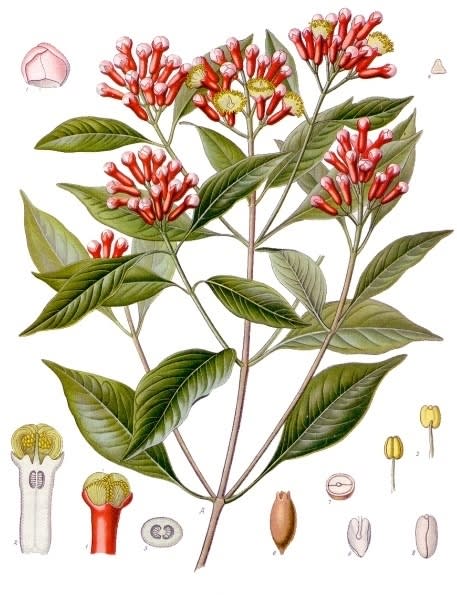
🌿 Morphology
🌞 Growing conditions
🌍 Origin and family
🌾 Uses
Warning: Despite the care taken in writing this sheet, it is essential to cross-reference sources before using or consuming any plant. When in doubt, consult a qualified professional
Permaculture uses
Cloves are primarily used as a spice in culinary applications. The essential oil extracted from the buds, leaves, and stems is used in aromatherapy and traditional medicine. The dried flower buds are used in mulching and composting, providing nutrients and pest deterrent properties to the soil. Eugenol, a major component of clove oil, possesses antiseptic and anesthetic properties. Clove oil is used in dental care and as a natural insecticide. Clove trees can be used in food forests as a long-term, multi-purpose crop.
Permapeople description
Syzygium aromaticum, commonly known as clove or clove tree, is an evergreen tree in the family Myrtaceae. It is native to the Maluku Islands (or Moluccas) of Indonesia. Clove is a spice made from the flower buds of the clove tree.
Botanical description
Syzygium aromaticum is an evergreen tree in the family Myrtaceae, native to the Maluku Islands (or Moluccas) in Indonesia. Growing to a height of 8–12 meters, it has a smooth grey bark and opposite, lanceolate leaves. The flower buds, which are the source of cloves, develop in small terminal clusters and are initially pale, gradually turning green, then bright red when ready for harvest. The flowers have a four-part calyx and four petals that form a small cap-like structure that detaches before the flower fully opens. The fruit is a dark red drupe, known as the 'mother of clove,' containing a single seed.
Companion planting
Specific companion planting information for clove trees is limited. However, considering its natural habitat, it may benefit from association with other tropical fruit trees and shade-tolerant plants. Avoid planting near plants sensitive to eugenol or that compete heavily for resources.
Propagation methods
Propagation is primarily through seeds, although vegetative propagation via cuttings and air layering is also possible but less common. Seeds should be sown soon after harvesting, as they have a short viability. Cuttings should be taken from semi-hardwood and rooted in a well-draining medium under humid conditions.
History and traditions
Cloves have been traded for centuries and were highly valued in ancient times. The Arabs controlled the clove trade for many years, followed by the Portuguese, Dutch, and then the English. Cloves have been used medicinally for centuries in various cultures, including traditional Chinese medicine and Ayurveda. They have been employed to relieve toothache, digestive issues, and as an antiseptic. Historically, cloves were used as a form of currency and were considered a luxury good.
Usage calendar
Flowering typically occurs during the dry season. Harvesting of the flower buds takes place when they turn bright red and are about to open. Planting is best done during the wet season. Pruning is generally minimal, focusing on removing dead or damaged branches and shaping the tree.
